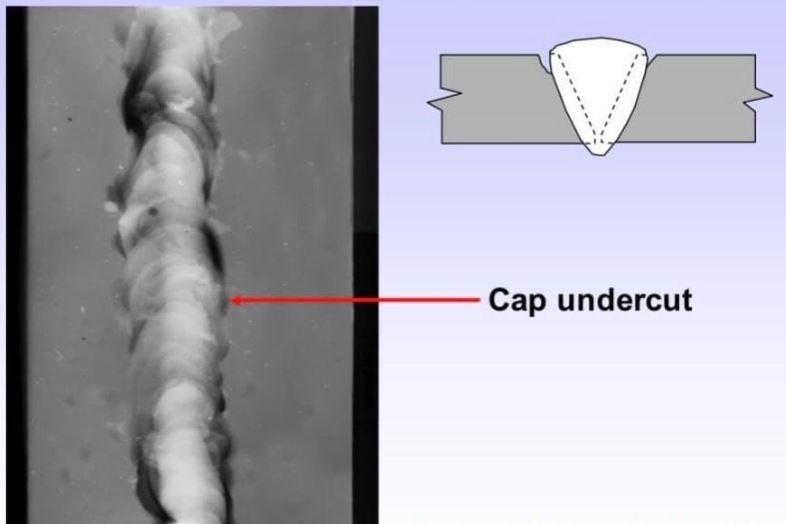Specialist Strategies for Preventing Weld Undercut Properly
Specialist Strategies for Preventing Weld Undercut Properly
Blog Article
Recognizing the Causes and Solutions for Undercut Welding in Steel Manufacture Procedures
In the world of steel manufacture procedures, the event of undercut welding postures a significant challenge that requires a comprehensive understanding of its reasons and viable options. The complex interaction of different elements during welding operations can lead to this undesirable sensation, influencing the structural honesty and total top quality of the bonded joints - Preventing weld undercut. By exploring the origin of undercut welding and discovering efficient restorative steps, makers can boost the criterion of their handiwork and ensure the production of perfect steel elements
Typical Reasons of Undercut Welding
Frequently overlooked in metal manufacture, undercut welding takes place due to different elements that demand careful interest and competence to be successfully reduced. Furthermore, inappropriate welding methods, such as making use of the wrong welding angle or take a trip rate, can additionally contribute to undercut formation. The selection of welding parameters, such as voltage, present, and cord feed rate, plays a considerable role in the event of undercut welding.
Influence of Incorrect Welding Parameters
Incorrect welding specifications can considerably compromise the integrity and high quality of welded joints in steel manufacture processes. The effect of inaccurate welding parameters manifests in numerous methods, bring about structural weaknesses and problems in the welded elements. One critical element influenced by improper welding specifications is the infiltration depth of the weld. Insufficient heat input because of low welding currents or excessively high traveling speeds can lead to inadequate blend in between the base metals, bring about insufficient joint infiltration and weakened bonds. Alternatively, extreme heat input created by high welding currents or slow travel speeds can cause excessive and burn-through reinforcement, creating a breakable and unsteady weld structure. Furthermore, inaccurate parameters such as inappropriate voltage settings or wrong electrode angles can contribute to unpredictable weld grain profiles, lack of blend, and raised chances of flaws like damaging. Meticulous attention to welding criteria is extremely important to make certain the production of top notch welds with the wanted mechanical properties and structural integrity.
Impact of Improper Lantern Angle
Improper torch angle in welding operations can considerably impact the high quality and honesty of the final weld joints in steel fabrication procedures. Damaging is a typical welding issue where a groove forms along the weld toe, compromising the joint and compromising its architectural stability.
A torch angle that is too steep can result in not enough penetration, insufficient combination, and raised spatter. On the other hand, a torch angle that is too shallow can lead to excessive infiltration, burn-through, and distortion of the base material. Preventing weld undercut. Proper lantern angle is necessary for making certain constant weld high quality, stamina, and look
To avoid undercutting and various other problems triggered by improper lantern angles, welders need to be trained to maintain the appropriate torch angle throughout the welding procedure. Regular surveillance and change of torch angles during welding can help achieve sound welds with marginal flaws.
Function of Inadequate Welding Techniques

One more facet of insufficient welding methods is inappropriate weld preparation. Inadequate cleaning of the base metals, wrong joint design, or inadequate side prep work can all add to damage welding. Furthermore, insufficient shielding gas insurance coverage or using the wrong kind of gas can cause insufficient fusion and the development of undercut issues.
To deal with the function of poor welding strategies in steel construction processes, it is vital to supply comprehensive training for welders. Appropriate education and learning on welding criteria, joint prep work, and securing gas choice can help avoid undercut welding and ensure high-quality welds in metal manufacture projects.
Reliable Solutions for Undercut Welding
Attending to undercut welding in metal fabrication needs executing effective services to improve weld high quality and architectural stability. Among the main remedies to battle undercut is to change you can try this out welding parameters such as voltage, present, and travel speed to make certain correct warmth input and combination. By fine-tuning these settings, welders can protect against extreme melting of the base steel and filler product, try here reducing the likelihood of undercut formation.
In addition, appropriate joint preparation is crucial in protecting against undercut. Ensuring clean base metal surfaces without impurities and utilizing the proper bevel angle can help advertise better weld infiltration and minimize the threat of undercut - Preventing weld undercut. Employing appropriate welding methods, such as oscillating the torch or weaving, can additionally aid in distributing warm equally and loading the weld joint sufficiently, decreasing the possibility of undercut defects
Moreover, picking the right welding consumables, consisting of electrodes and filler steels, is important in reducing undercut. Utilizing materials with appropriate chemical compositions and mechanical properties can contribute to achieving sound welds with minimal undercut. Routine assessment and top quality control steps need to also be applied to detect and deal with undercut concerns quickly, guaranteeing the article overall integrity of fabricated steel elements.

Final Thought
In final thought, understanding the causes and remedies for undercut welding in metal manufacture procedures is vital for achieving high-grade welds. By addressing usual causes such as inaccurate welding parameters, inappropriate lantern angle, and poor welding methods, welders can avoid undercutting and make sure solid, durable welds. It is necessary to take note of these factors and implement efficient options to boost the general welding process and final item top quality.

Report this page